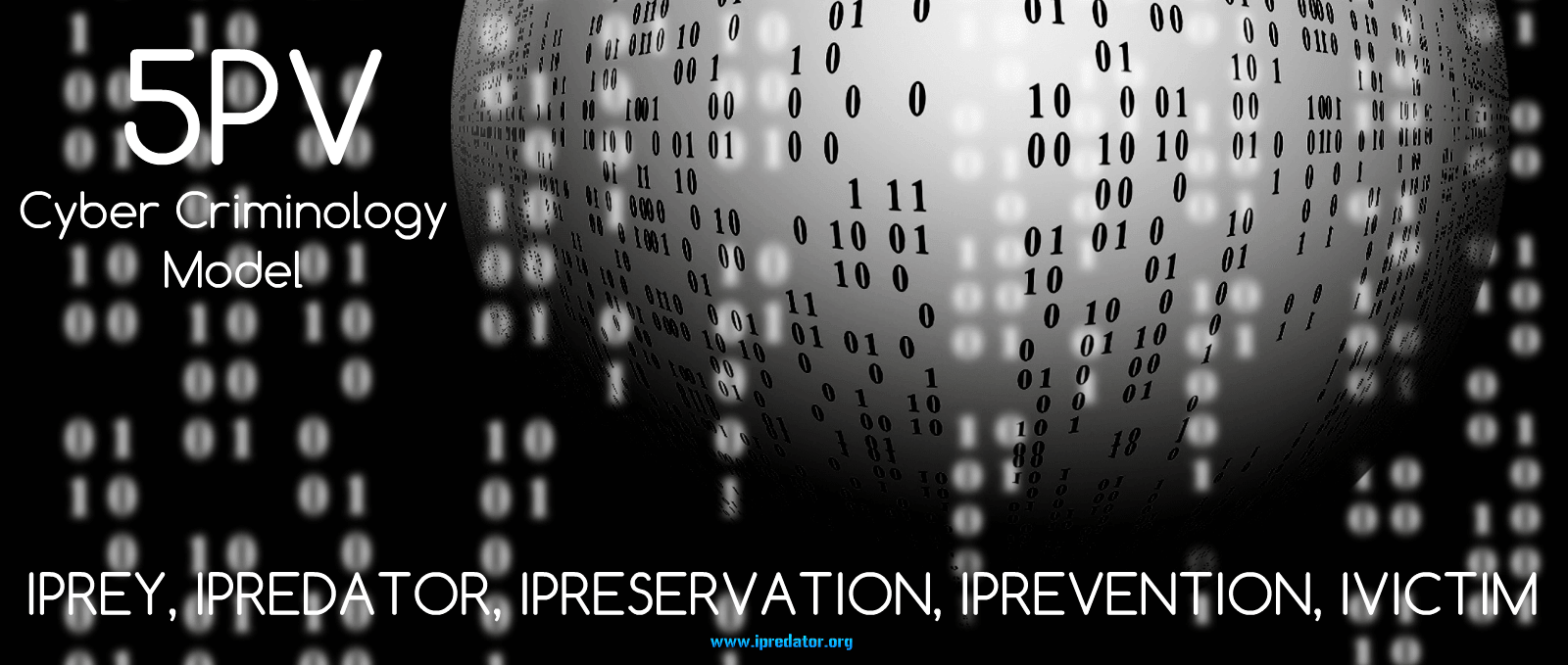
Cybercriminal 5PV Model
of
iPredator and Online Victims
5PV Model: 5PV is a cybercriminal five factor theoretical model used to define all interactions between people who use Information and Communications Technology (ICT) for personal and/or benevolent reasons and those who use ICT for selfish, nefarious and/or malevolent reasons. The five terms of 5PV are iPredator, iPrey, iPrevention, iPreservation and iVictim. The 5PV model is a representation of the five elements involved in criminal, deviant and abusive human interactions as they relate to the Internet and Information and Communications Technology. The primary difference between this model and all other criminal, deviant and abuse areas is the environment. The artificial environment is cyberspace and benefits the iPredator.
Unlike any other territory, humanity has explored since the beginning of human civilization, cyberspace is a frontier where the potential iVictim has little grasp to evaluate social exchanges in a realistic way. For the first time in human history, the Internet has given human predators and iPredators pristine anonymity. iPredators can create a persona they consider proper in their tactical strategy to meet success in their methods of stalking.
Without fear of identification, iPredators have the free rein to behave, interact and personify what they believe to be their most successful strategy. For example, a forty-year old man can now create a profile to be exactly what he feels is most plausible to his target. If his prey is a fourteen-year-old female, he can download false images, develop a creative background and interact with his adolescent target as someone close to her age and stage in life. Prior to the Information Age, this was not possible.
Cyberspace and the online world afford iPredator a pristine virtual reality. Virtual reality is a term that applies to computer-simulated environments that can simulate the physical presence in places in the real world, as well as in imaginary worlds. For the first time in human civilization, the human predator, iPredator, has total anonymity. iPredators do not have to hide behind the proverbial bushes and can skulk about in the dimension of cyberspace and virtual reality undetected, hidden and cloaked to perfection.
iPreservation: iPreservation is the goal iPrey attempts to practice lowering his/her probability of becoming an iVictim at the hands of an iPredator. iPrey strives for iPreservation by practicing iPrevention. The definition of iPreservation is both a state of being and a diligent practice. When someone is consciously aware iPredator exists and they seek vulnerable iVictims, the online user experiences a sense and/or need to keep their sanctity and safety.
The motivation for iPreservation is not based in fear of iPredator, but awareness they exist. By utilizing iPrevention tactics, the online user reduces his/her potential of becoming an iVictim while accessing and interfacing with Information and Communications Technology.
Just as all-living organisms have a genetic and/or instinctual need to survive, humans who interact with cyberspace and Information and Communications Technology experience iPreservation. Although iPreservation is instinctual in all online users, the level of iPreservation an online user experiences and conscious of, falls along a continuum of awareness ranging from non-existent to perpetually. For example, internet safety experts highly recommend online users, when posting information on their Facebook or social networking profiles to never post their full name, home address and contact information.
Although most online users will understand this commonsense recommendation, there still are thousands of online users who do not practice this basic Internet safety rule. Do these online users not know how dangerous it is or simply do not care? Online users who experience the state of iPreservation would not have to be told or recommended to not disclose this information in cyberspace, because they know it is common sense not too. For those online users who do not practice iPrevention or experience iPreservation, they fall in the unfortunate class of iVictims.
The profile of the iVictim is the ideal target iPredator seeks for criminal, deviant and abusive endeavors. The iVictim is not bound to stay as such but does not take the necessary steps required to reduce their probability for becoming a target. iVictims tend to practice denial, ignorant to Internet safety, mistakenly view themselves as technologically astute or believe they are outside the purview of iPredator. iPredators believe that their criminal, deviant or abusive pursuits are fueled by their own distorted perceptions of iPreservation.
For most iPredators, they believe they must harm, abuse and victimize others in order for them to thrive, and sometimes, to survive. The symbolic equation is as follows:
iPrey x iPrevention = iPreservation

iPrevention: iPrevention is a conscious strategy, effort and sustained approach to reducing the probability of becoming an iVictim by iPredator. The iVictim is not bound to stay as such but does not take the necessary steps required to reduce their probability for becoming a target. iVictims do not practice iPrevention. iVictims tend to practice denial, view themselves as technologically astute, and/or outside the purview of iPredator. What online users can do to significantly reduce their probability of becoming a target of an iPredator is practice iPrevention.
iPrevention strategies involve a concerted effort to learn personal aspects and relevant demographic information that increases their chances of becoming a target. Age, gender, financial status, psychological preparedness and Internet aptitude are areas that define an online user’s probability of becoming a target. Effective iPrevention requires a multi-step process for protection and insulation lasting the life of the online user who actively interfaces with Information and Communications Technology. Success with iPrevention requires acceptance the pursuit is a lifelong process.
As Information and Communications Technology will always advance, iPrevention as well must be a consistent effort. This is not to say thorough iPrevention requires advanced training in Information and Communications Technology. What is required is a willingness to practice awareness and confirmed acceptance iPredators will always be perceptive with technological advancements. Under the theory of iPrevention, the goal is not to be a step ahead of iPredator, but to be aware iPredators are always on the prowl in cyberspace and using Cyberstealth methods to stalk their prey.
Online users who practice iPrevention actively study and learn Internet safety practices, iPredator typologies, state and local laws of iPredators and intervention steps if the online user or their loved ones and/or their business is cyber attacked or engaged by an iPredator. By utilizing iPrevention tactics, an online user reduces his/her potential of becoming an iVictim while accessing and interfacing with Information and Communications Technology. The symbolic equation is as follows:
iPreservation x iPredator = iPrevention
iPredator: A person(s) who engages in victimizing others using Information and Communications Technology motivated by deviant sexual fantasies, aggressive needs for power and control, retribution, religious/political retribution, psychiatric/psychological manifestations and/or personal/financial gain. Cyberstalkers, cyberbullies, cyber terrorists, cybercriminals and online sexual predators all use “Cyberstealth” afforded by the internet, social networking and social media to stalk their prey. Under this theory, iPredator revels in his/her Internet anonymity, quickly becomes grandiose from his criminal accomplishments and fueled by the knowledge that he/she can freely troll for his/her victims, immune from law enforcement, identification or apprehension.
As Information and Communications Technology gradually replaces human contact and reality based social relationships, humanity will become increasingly disconnected not realizing they increase their probability for becoming a target of iPredator. iPredator stalks quarry he/she evaluates as not practicing iPrevention or engaged in the attempt of iPreservation. iPrevention is a conscious strategy, effort and sustained approach to reducing the probability of becoming an iVictim of iPredator. iPreservation is the goal iPrey attempts to practice lowering his/her probability of becoming an iVictim at the hands of iPredator.

iPrey is the population of online users, which iPredator stalks and is an inclusive term for all humanity who uses the Internet, Information and Communications Technology, and Mobile Device Technology. iPredator seeks out and stalks those he/she has evaluated to be devoid of practicing iPrevention. By utilizing iPrevention tactics, the online user reduces his/her potential of becoming an iVictim, while accessing and interfacing with Information and Communications Technology. iPredators rely upon, and most often succeeds, when online users do not practice iPrevention strategies for Internet safety and cyber security. The symbolic equation is as follows:
iPrey: iPrey is an inclusive term for all humanity who uses Information and Communications Technology. Exactly as all living predators hunt, iPredators stalk iPrey using tactical strategies to increase their probability for success. The only humans, who are not included in the class of iPrey, are those who do not interface with the Internet.
With each passing year, the global expansion of Information and Communications Technology will one day include most humanity ranging from industrialized countries to nations considered impoverished and/or technologically delayed. As cost decreases about Information and Communications Technology, the population of iPrey will steadily grow and will inevitably become all humans walking the face of the planet.
Once again, iPredator uses the same methodologies wild predators use in their hunt for food. The only difference being iPredators do not stalk for food, survival, procreation and/or territory. iPredators stalk their quarry for deviant sexual needs, sociopathic endeavors, criminal intentions or a psychiatric modus operandi. iPredators tend to be male, but female iPredators will grow steadily as Information and Communications Technology becomes more commonplace in daily living. iPrey can be low, medium, or high probability targets. Low probability iPrey are people who engage in iPrevention consciously aware there are malevolent and/or nefarious online users who will attempt to victimize them if they lower their guards down.
Medium probability targets are iPrey who engage in iPrevention consciously aware there are malevolent and/or nefarious online users who will attempt to victimize them if they lower their guards down, but cannot fully insulate themselves given their age, gender or financial status. This is not to say that the young, women or senior citizens cannot practice iPrevention or insulate themselves from victimization, but factors outside their control place them in preferred target populations of iPredators.
High probability targets are people who do not practice iPrevention strategies for various reasons. High probability targets not only do not practice iPrevention, but medium probability targets, are included in iPredator’s target market given their gender, age or financial status.
iPrey who are high probability targets for iPredator are defined as iVictims. iVictims are defined as people who interface with Information and Communications Technology and the Internet devoid of the necessary insulation strategies, levels of awareness, healthy forms of skepticism and structured tactical methods when interfacing with cyberspace. Unlike iVictims, iPrey have options to not only reduce their probability of becoming iVictims, but can assist their loved ones from becoming iVictims as well. iPrey use iPrevention strategies reducing their potential for becoming an iVictim.
iPrevention strategies are specific steps a person takes to reduce theirs or their loved one’s chances of becoming a target of an iPredator. By utilizing iPrevention tactics, the online user reduces his/her potential of becoming an iVictim, while accessing and interfacing with Information and Communications Technology. The following symbolic equation represents a basic formula for cyber protection and Internet safety.

iPrevention x iPreservation = iPrey
iVictim: iVictim is a person who interfaces with Information and Communications Technology devoid of the necessary insulation strategies, levels of awareness, a healthy form of skepticism and structured tactical methods when interacting with cyberspace. The profile of the iVictim is the ideal target iPredators seek for their criminal, deviant or abusive endeavors. The iVictim is not bound to stay as such but does not take the necessary steps required to reduce their probability for becoming a target.
iPredator is a person(s) who engages in victimizing others using Information and Communications Technology motivated by deviant sexual fantasies, aggressive needs for power and control, retribution, religious/political retribution, psychiatric/psychological manifestations or personal/financial gain.
Cyber stalkers, cyber bullies, cyber terrorists, cyber criminals, sexual predators and white-collar fraud artists all use “Cyberstealth” afforded by the Internet, social networking and social media to stalk iPrey. iVictims tend to practice denial, view themselves as technologically astute and/or think they are outside the purview of iPredators.
Just as all living organism predators stalk their prey, iPredators seek online users they have deemed as approachable, easily engaged and unlikely to stop their cyber-attack. In the wild, predators stalk and hunt prey they have evaluated to be a highly probable target. They stalk and hunt prey they have evaluated to be the weakest and least intimidating. The most vulnerable targets for the predator and iPredator are the young, the old, the ignorant and the disabled either by physical and/or psychological deficits.
Given the majority of iPredators tend to be gender male, they often target female given their distorted assessment that women are less clever and/or weaker. Ignorance (not knowing), discouragement, psychologically compromised, lack of skepticism, isolation and curiosity are but a few traits iPredators look for in their hunt. It is for these reasons that children and adolescents are often prime targets. In addition to being adept at practicing Cyberstealth, iPredators are trained at sensing the mentioned attributes they consider necessary to start their hunt. By utilizing iPrevention tactics, the online user reduces his/her potential of becoming an iVictim when accessing and interfacing with Information and Communications Technology.
By not practicing Internet safety, online users have an increased probability of being victimized by human predators when interfacing with Information and Communications Technology. Because the iVictim is a target of iPredator, their online experiences often include higher rates of cyber bullying, cyber stalking, cyber sexual abuse, online sexual solicitations, online fraud/scams and identity theft. Just as there is controversy within the fields of criminal justice, law enforcement and criminology related to the reasons why people become and/or allow themselves to become victims, the same controversial positions apply to iVictims and cybercrime.
Given how easy it is for human predators to hide their identities when online, it becomes paramount for all people using Information and Communications Technology and the Internet to practice the necessary steps to reduce their potential from being victimized. The following symbolic equation represents a basic formula for iVictim:
iPredator + iPrey – iPrevention – iPreservation = iVictim
Michael Nuccitelli, Psy.D.
Michael Nuccitelli, Psy.D. is a NYS licensed psychologist, cyberpsychology researcher and online safety educator. In 2009, Dr. Nuccitelli finalized his dark side of cyberspace concept called iPredator. Since 2010, he has advised those seeking information about cyberbullying, cyberstalking, cybercriminal minds, internet addiction and his Dark Psychology concept. By day Dr. Nuccitelli is a practicing psychologist, clinical supervisor and owner of MN Psychological Services, PLLC. After work and on the weekends, he volunteers helping online users who have been cyber-attacked. Dr. Nuccitelli’s is always available to interested parties and the media at no cost. This website and everything created by Dr. Nuccitelli is educational, free and public domain.
iPrey x iPrevention = iPreservation

